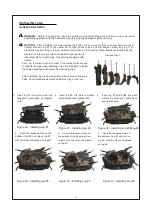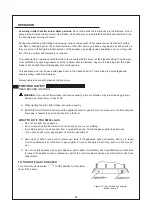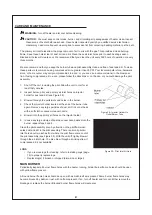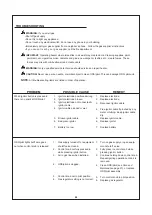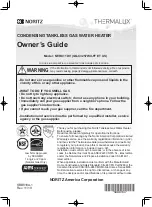
8
WATER VAPOR: A BY-PRODUCT OF UNVENTED ROOM HEATERS
Water vapor is a by-product of gas combustion. An unvented room heater produces approximately one () ounce
(30ml) of water for every ,000 BTUs (.3KWs) of gas input per hour. Unvented room heaters are recommended
as supplemental heat (a room) rather than a primary heat source (an entire house). In most supplemental heat
applications, the water vapor does not create a problem. In most applications, the water vapor enhances the low
humidity atmosphere experienced during cold weather.
The following steps will help insure that water vapor does not become a problem.
1. Be sure the heater is sized properly for the application, including ample combustion air and circulation air.
2. If high humidity is experienced, a dehumidifier may be used to help lower the water vapor content of the air.
3. Do not use an unvented room heater as the primary heat source.
WARNING:
A qualified technician must install heater. Follow all local codes.
WARNING:
Before installing in a solid flue burning firebox, the chimney flue and firebox must be cleaned of
soot, creosote, ashes and loose paint by a qualified chimney cleaner. Creosote will ignite if highly heated. A
dirty chimney flue may create and distribute soot within the house. Inspect chimney flue for damage.
WARNING:
Maintain the minimum clearances.
If possible, provide greater clearances from the
floor, ceiling, and adjoining wall than required.
Minimum Fireplace Clearance to Combustible Materials
Log size
Side wall
Ceiling
8 in, 4 in
6 in.
4 in.
PREPARING FOR INSTALLATION
Before beginning assembly or operation of the product, make sure all parts are present. Compare parts with
package contents list and diagram above. If any part is missing or damaged, do not attempt to assemble, install
or operate the product. Contact customer service for replacement parts.
Estimated Assembly Time:
to hours
Tools Required for Assembly:
Before installing heater, make sure you have the items listed below
Hardware package (provided with heater)
Approved flexible gas hose (not provided) if allowed by local codes
Sealant (resistant to natural or propane/LP gas, not provided)
Electric drill with 3/16” drill bit
Phillips screwdriver
External regulator (supplied by installer)
Piping (check local codes)
Equipment shutoff valve
Test gauge connection
Sediment trap
Tee joint
Pipe wrench
UNPACKING
. Remove logs and burner base assembly from carton.
NOTE:
Do not pick up burner base assembly by burn-
ers as this could damage heater. Always handle base assembly by grate.
. Remove all protective packaging applied to logs and heater for shipment.
3.
Check all items for any shipping damage. If damaged, promptly inform dealer where you purchased the
heater.
•
•
•
•
•
•
•
•
•
•
•
•
Summary of Contents for GLD1850
Page 27: ...27 27...
Page 29: ...29 29 Printed in China...

















